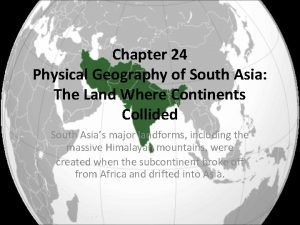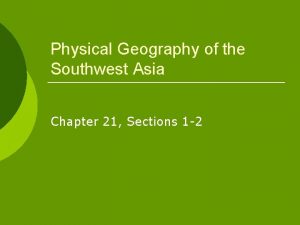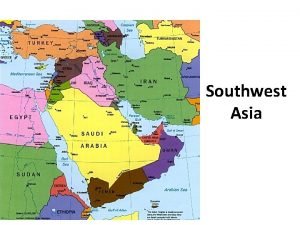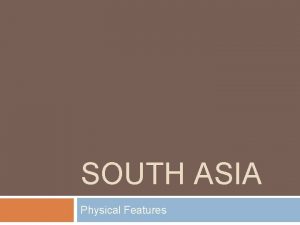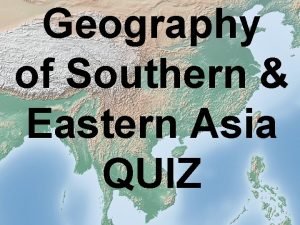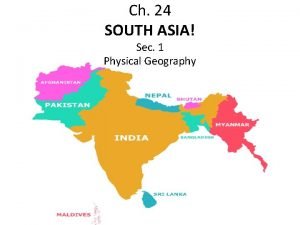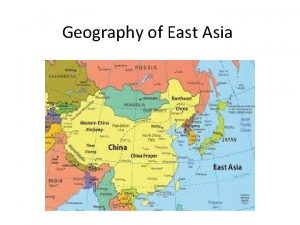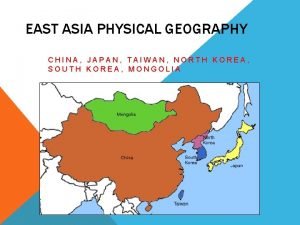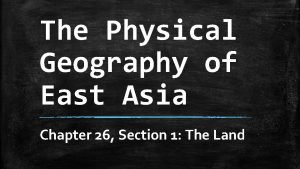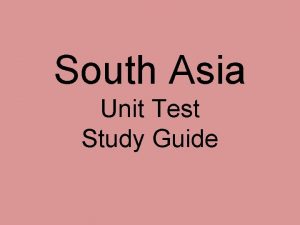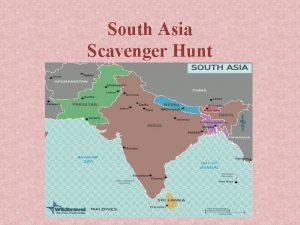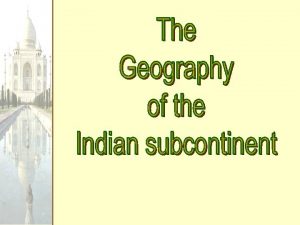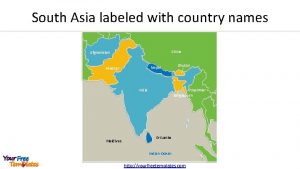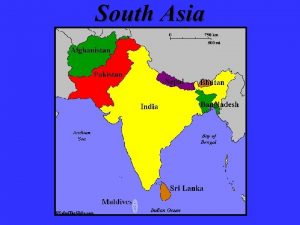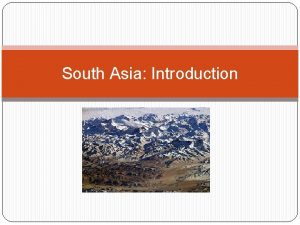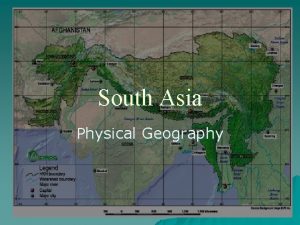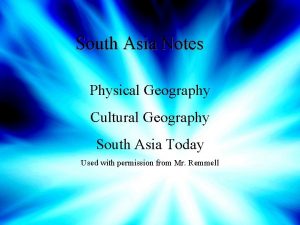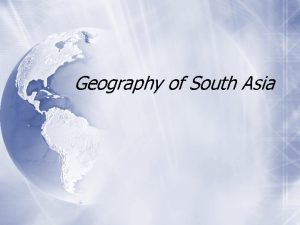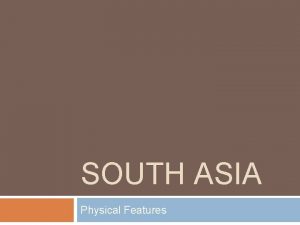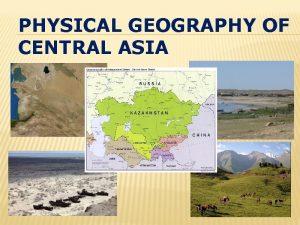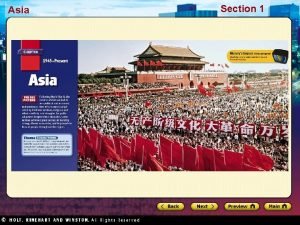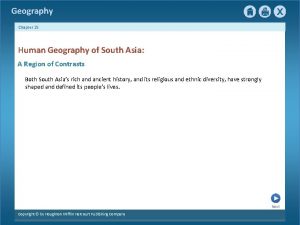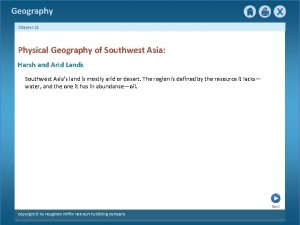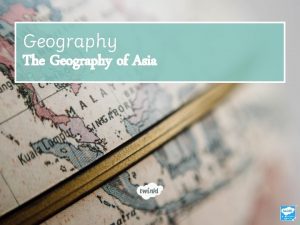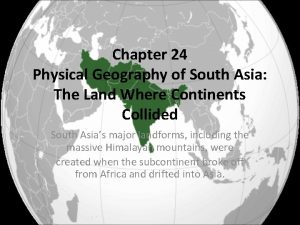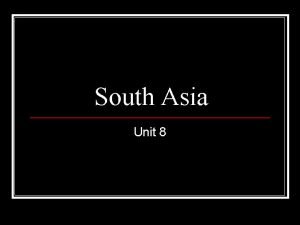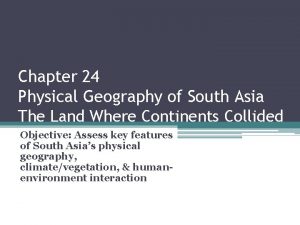CHAPTER 24 PHYSICAL GEOGRAPHY OF SOUTH ASIA THE





















- Slides: 21

CHAPTER 24 PHYSICAL GEOGRAPHY OF SOUTH ASIA: THE LAND WHERE CONTINENTS COLLIDED South Asia’s major landforms, including the massive Himalayan mountains, were created when the subcontinent broke off from Africa and drifted into Asia.

The Indian Subcontinent - Countries: • India, Pakistan, Bangladesh, Bhutan, Nepal, Sri Lanka, the Maldives - Subcontinent: large landmass that’s smaller than a continent

MOUNTAINS AND PLATEAUS South Asia was once part of East Africa § Split off 50 million years ago and collided with Central Asia Collision of tectonic plates pushed land into huge mountain ranges Himalaya Mountains — 1, 500 milelong system of parallel ranges § Include world’s tallest mountain—Mt. Everest § Form barrier between Indian subcontinent and China § Kingdoms of Nepal, Bhutan are also in these mountains

MOUNTAINS AND PLATEAUS South Asia was once part of East Africa § Split off 50 million years ago and collided with Central Asia Collision of tectonic plates pushed land into huge mountain ranges Himalaya Mountains — 1, 500 milelong system of parallel ranges § Include world’s tallest mountain—Mt. Everest § Form barrier between Indian subcontinent and China § Kingdoms of Nepal, Bhutan are also in these mountains


MOUNTAINS AND PLATEAUS • At west end, Hindu Kush mountains separate Pakistan, Afghanistan • Historically blocked invasions from Central Asian tribes • Khyber Pass is one of the major land routes through the mountains • Karakoram Mountains are in northeastern part of Himalayas • Include world’s second highest peak, K 2

RIVERS, DELTAS, & PLAINS The Indus & Ganges are two of the greatest river systems in South Asia These rivers play a key role in supporting life in South Asia When the rivers overflow their banks, they deposit rich soil on alluvial plains (rich farmlands) The Indo-Gangetic Plain is also the most heavily populated part of South Asia

RIVERS, DELTAS, & PLAINS The Indus & Ganges are two of the greatest river systems in South Asia These rivers play a key role in supporting life in South Asia When the rivers overflow their banks, they deposit rich soil on alluvial plains (rich farmlands) The Indo-Gangetic Plain is also the most heavily populated part of South Asia

GANGES RIVER A Sacred River Hinduism is the religion of most Indians To Hindus, the Ganges River is the sacred home of the goddess Ganga § Hindus believe waters have healing powers; temples line its banks § Pilgrims come to bathe, scatter ashes of dead § At sacred site of Varanasi they gather daily for prayer, purification § Float baskets of flowers, burning candles on water

GANGES RIVER A Polluted River Centuries of use have made Ganges most polluted river in world § Sewage, industrial waste, human bodies poison the water Users get stomach and intestinal diseases, hepatitis, typhoid, cholera I n 1986, government plans sewage treatment plants, regulations § Today few plants are operational, factories still dump waste § Clean up will take time, money, a change in how people see river

OFFSHORE ISLANDS Sri Lanka & the Maldives are located in the Indian Ocean § Sri Lanka is a large tropical island with great natural beauty Maldives comprise an archipelago (1200 k islands, 200 of which are inhabitated) § They are considered atoll islands § Low-lying tops of submerged volcanoes § Look like ring-like coral island or string of small islands surrounding a lagoon

OFFSHORE ISLANDS Sri Lanka & the Maldives are located in the Indian Ocean § Sri Lanka is a large tropical island with great natural beauty Maldives comprise an archipelago (1200 k islands, 200 of which are inhabitated) § They are considered atoll islands § Low-lying tops of submerged volcanoes § Look like ring-like coral island or string of small islands surrounding a lagoon

NATURAL RESOURCES The subcontinent coasts a wide variety of natural resources that support human life South Asia relies heavily on soil & water resources to provide food through farming & fishing Water also provides a means of transportation & power Forest products are another important resource in South Asia is abundant in coal & iron ore & other metals


CONTINUED NATURAL RESOURCES Minerals § India § Fourth in world in coal production, has petroleum, uranium § Mica for electrical equipment and growing computer industry § Known for diamonds § Iron ore from India’s Deccan Plateau used in steel industry, exported § Sri Lanka § Known for sapphires, rubies § Pakistan, Bangladesh § Have natural gas resources


CONTINUED NATURAL RESOURCES Forests Deforestation is a severe problem § Causes soil erosion, flooding, landslides, loss of wildlife habitats § Overcutting has devastated forests in India, Bangladesh, Sri Lanka


CLIMATE—WET AND DRY, HOT AND COLD Monsoons and Cyclones Monsoons—seasonal winds that affect entire region § Dry winds blow from northeast October–February § Moist ocean winds blow from southwest June–September § Moist winds bring heavy rainfall, especially in southwest, Ganges Delta § Unpredictable; cause hardship in lowlands of India, Bangladesh Cyclone—violent storm with fierce winds, heavy rain § In Bangladesh low coastal region swamped by high waves


 South asia physical geography
South asia physical geography Chapter 25 human geography of south asia
Chapter 25 human geography of south asia Chapter 27 section 1 landforms and resources
Chapter 27 section 1 landforms and resources Map of southwest asia
Map of southwest asia Chapter 21 physical geography of southwest asia
Chapter 21 physical geography of southwest asia Reteaching activity 24 cultural geography of south asia
Reteaching activity 24 cultural geography of south asia Physical features map of south asia
Physical features map of south asia Southern and eastern asia physical features answer key
Southern and eastern asia physical features answer key Tear
Tear East asia physical geography
East asia physical geography Taiwan physical geography
Taiwan physical geography Chapter 15 lesson 1 physical geography of north africa
Chapter 15 lesson 1 physical geography of north africa Physical geography of east asia
Physical geography of east asia Kums definition geography
Kums definition geography Latin america webquest answers
Latin america webquest answers Lesson 1 physical geography of south america
Lesson 1 physical geography of south america Chapter 22 human geography of southwest asia
Chapter 22 human geography of southwest asia South west asia and north africa map
South west asia and north africa map South asia unit test
South asia unit test South asia scavenger hunt
South asia scavenger hunt South asia satellite
South asia satellite South asia map and capitals
South asia map and capitals
